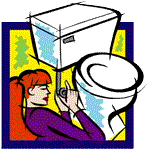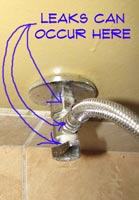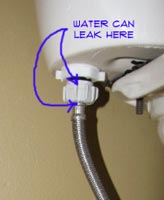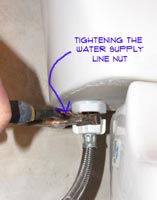
There are four possible places that a toilet supply line can leak. Sometimes it is difficult to tell where the water is coming from. It is possible for water to be leaking from the tank and running down the supply line, making it appear that the supply line or valve is the problem.
Not sure if this is your problem? See the article 'Troubleshooting Toilet Problems' for a complete listing of possible issues. For general plumbing questions, see 'Plumbing Repair for Homeowners'.
Since leaks can be deceptive and water runs down hill, we will work from the top down in locating the leak.
Be Careful
Older toilets may have corroded brass lines and corroded fittings. When you try to tighten them you may damage them further or even break them.
Locating Toilet Supply Line Leaks
We will work from the toilet back to the wall to locate the problem. Use a dry rag and your finger to determine which spot is leaking. (1) At the nut that connects the supply line to the Fill Valve. (2) The nut that connects the supply line to the shut off valve. (3) The connection where the valve attaches to the water line. (4) The washer in the valve itself.
Fill Valve Inlet Nut
 Use a pair of adjustable pliers or an adjustable wrench to tighten the nut that attaches to the Fill Valve. Do not over tighten. Make sure the nut is not cross threaded before you start to tighten. You should be able to make several turns by hand without difficulty. Some older nuts may have a loose washer that may have gone bad. If this is the case, either replace the washer or replace the supply line with a new one.
Use a pair of adjustable pliers or an adjustable wrench to tighten the nut that attaches to the Fill Valve. Do not over tighten. Make sure the nut is not cross threaded before you start to tighten. You should be able to make several turns by hand without difficulty. Some older nuts may have a loose washer that may have gone bad. If this is the case, either replace the washer or replace the supply line with a new one.
Supply Line Valve Nut
The nut that attaches the supply tube to the valve can also be tightened. Use both a pair of pliers and an adjustable wrench when you do this. Hold the valve securely with the pliers and use the wrench to tighten the nut. Take it easy until the leak stops. If the leak won't stop, you may have to replace the supply line. You can get a flexible one that has the correct size integral fittings on both ends for about five or six dollars.

Valve Connection at Water Line
There are two types of connections at the water line. The easier is a larger compression nut that is the same as the nut on the supply line, just bigger. Before you try working on a water supply valve it is a good idea to turn off the water. Especially if the valve is old.
Tighten this nut in the same way you would the smaller one. Use the pliers to hold the valve and the wrench to tighten the nut. Tighten it until the leak stops. Turn the water back on to check for leaks as needed. Take your time and be careful.
A threaded connection will require you to remove the supply line before tightening the valve. You will need to hold the nut on the water line with a wr
ench and use another wrench or large pliers to turn the valve. You can try tightening it one full turn or a portion of a turn. Turn the water back on to check for leaks. If the leak stops, re-attach the supply line, if not, try to tighten some more.
Shut Off Valve
The shut off valve has a washer inside of the housing that keeps it from leaking. A large nut under the handle holds the assembly in place. If the water is coming out around the stem then try tightening this nut. Hold the valve with the pliers and use a wrench to tighten.
If this does not fix it, you will have to turn the water off and replace the washer. Obtain the right sized washer and replace. You can also replace the entire valve. Get a quarter turn ball cock valve if you do. They have far fewer problems.
Toilet Supply Line Leaking – Summary
Toilet supply lines generally leak at one of the connections, either at the toilet tank or at the valve. Often, you can solve the problem by tightening the fitting.

